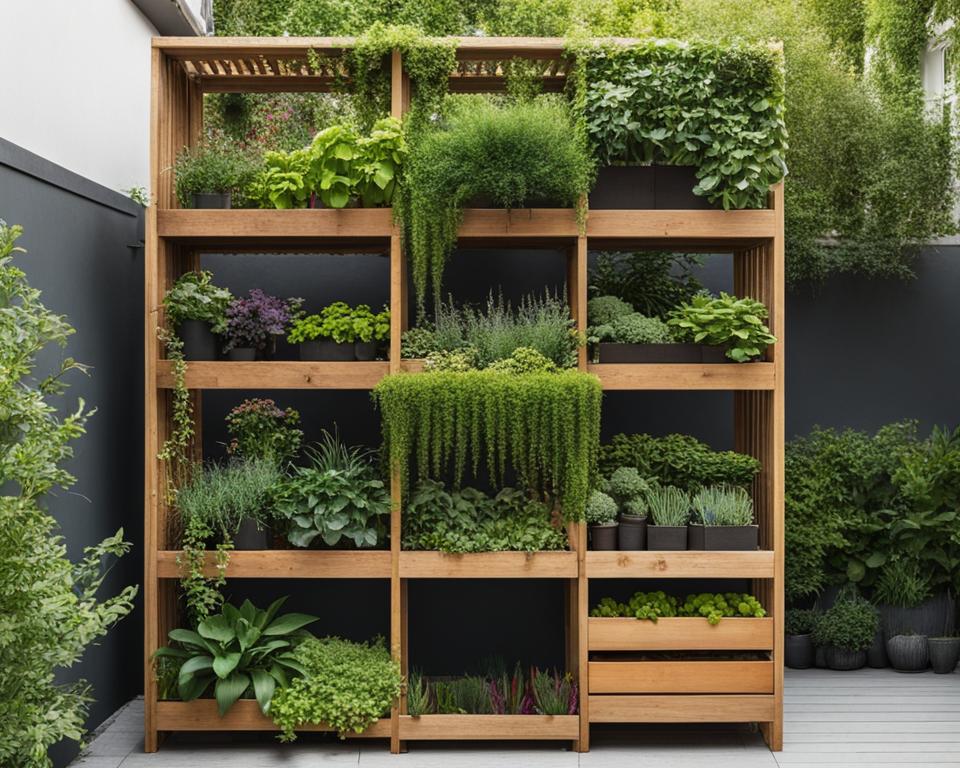As populations grow and personal footprints shrink, the value of space has skyrocketed, particularly in urban areas like Baton Rouge. With spring ushering in a time of renewal and growth, it’s the perfect opportunity to redefine the dimensions of horticulture with vertical gardening. By directing the bountiful vigor of nature upwards, you create a lush tapestry against the sky, a living art piece that not only maximizes your available space but also transforms it entirely.
Whether you’re an aficionado of fresh vegetables or have a penchant for decorative foliage, vertical garden design brings you closer to nature’s grace without the sprawl of traditional gardens. You can infuse life into every nook, from patios and balconies to interior walls and windowsills, turning the vertical into a verdant stage for a variety of plants to perform. Embrace these gardening tips to elevate your green thumb status and make the most of your space.
With vertical gardens, creativity knows no bounds. To repurpose common yard items—think wall planters ingeniously crafted from gutters or the charm of a trellis-laced bottle garden—serves to both challenge and delight the DIY enthusiast. Best of all, vertical gardening can simplify your life: less bending over means less back strain, and the ease of maintenance from weeding to harvesting becomes nothing short of a gardener’s dream.
Key Takeaways
- Optimizing limited outdoor space with creative vertical garden design
- Bringing a variety of plants including vegetables, annuals, and perennials to life in a vertical format
- The convenience of vertical gardening by minimizing physical exertion during weeding and harvesting
- Implementing repurposed materials for innovative DIY vertical gardening projects
- Enhancing the aesthetic appeal of your dwelling, inside or out, thanks to clever vertical arrangements
- The versatility of vertical gardening techniques suitable for both indoor and outdoor environments
Introduction to Vertical Gardening
When you reimagine the walls and fences around you as potential canvases for verdant splendor, you unlock the elegant artistry of vertical gardening. This innovative approach not only maximizes space but also infuses your environment with a soothing aesthetic brilliance. Whether you’re contemplating a peaceful alcove bustling with greenery or revamping an urban corner, vertical gardening ideas provide endless inspiration. If you’re curious how to start vertical gardening, it begins with envisioning the potential of your vertical spaces and choosing a system that accommodates your horticultural aspirations.
Urban dwellers find vertical gardens to be a transformative solution. These vertical oases thrive despite limited horizontal expanses. They can take the form of green walls that breathe life into concrete landscapes or trellis structures that support climbers and create living art installations. But beyond their allure, how do these vertical gardening systems work? They are symbioses of design and nature, utilizing modular arrangements that permit plants to grow upward—these systems ingeniously surprise space while integrating seamlessly into your daily living spaces.
| Vertical System | Best for | Maintenance Level |
|---|---|---|
| Trellises | Vining plants & climbers | Low to moderate |
| Living/Green Walls | Herbs, ferns, small flowers | Moderate to high |
| Modular Towers | Vegetables & strawberries | Low to moderate |
| Hanging Pots | Ornamentals & succulents | Low |
Delving into vertical gardening can seem daunting at first, but the key is to establish a direction and choose the appropriate setup that aligns with your lifestyle and the environmental conditions of your space. Consideration must be given to factors such as light exposure, weight limitations, and plant preferences. Whether you seek the rustic appeal of a repurposed pallet garden or the modern chic of a hydroponic green wall, beginning your journey into vertical gardening is an enriching endeavor that rejuvenates both space and spirit.
The Art of Vertical Garden Design
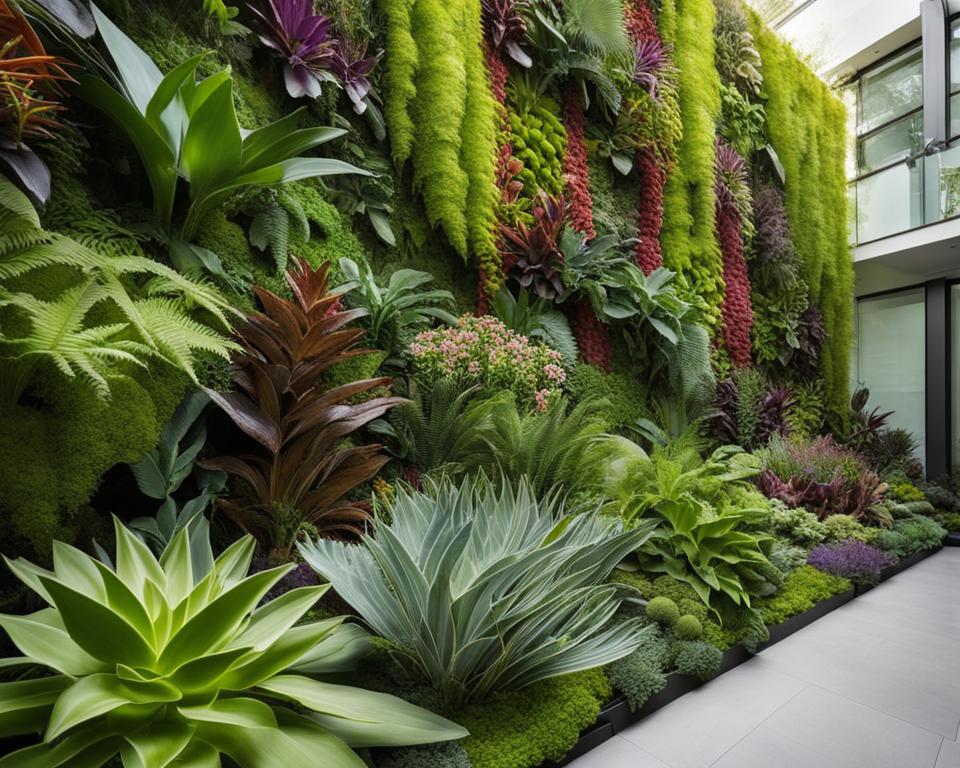
When you delve into the world of vertical gardening, the structures you choose are not just mere supports; they are the canvas on which you’ll paint your green masterpiece. Whether you’re aiming to enhance home greenery or create a functional piece of living art, understanding vertical gardening techniques is essential. A thoughtfully designed vertical garden not only optimizes your space but also adds a dynamic visual element to your vicinity. Below, we’ll explore how to select the right structure that meets both your aesthetic desires and gardening needs.
Choosing the Right Structure for Your Space
Selecting the perfect structure for your vertical garden design requires considering factors such as the dimensions of your space, the intensity and duration of sunlight it receives, and your individual plant preferences. Common, practical items have the potential to be transformed into impressive vertical garden structures. For instance, gutters and repurposed buckets can find new life as planters for a variety of greenery, while PVC pipes prove to be durable and adaptable components for your vertical gardening project.
Incorporating Aesthetics and Functionality
Your vertical garden should not only fulfill a utilitarian role but should also be a source of visual pleasure. Climbing plants, for example, provide a natural flourish when paired with trellises made from bamboo, lumber, or metal poles. These materials not only support your greenery but also add a touch of elegance to your design, reinforcing the idea that vertical gardens are indeed an art form.
Here is an insightful table that highlights some ideal combinations of plants and structures to get you started with your vertical garden design:
| Plant Type | Structure Type | Material | Benefits |
|---|---|---|---|
| Vines and Climbers | Trellises | Wood/Bamboo | Natural look, easy to customize |
| Herbs and Small Vegetables | Wall Planters | Metal/Plastic | Space-saving, convenient harvest |
| Flowering Annuals | Repurposed Gutters | Aluminum | Long planting area, improves visual appeal |
| Edible Perennials | PVC Towers | PVC Pipes | Vertical growth, compact layout |
Embracing the breadth of vertical gardening techniques and drawing inspiration from the world around you, you’re on your way to crafting a vertical garden that is both productive and picturesque. The key to success lies in a balance between what works best for your plants and your own vision for a garden that enhances the ambiance of your home with thriving greenery.
How to Start Vertical Gardening
Embarking on your vertical gardening journey ignites a world of possibilities, allowing you to experience the vertical gardening benefits firsthand. This innovative approach not only saves space but also creates a unique visual appeal in any area of your home, whether indoors or out.
Selecting Suitable Plants for Vertical Spaces
Finding the best plants for vertical gardening starts with understanding which varieties thrive when growing upwards. For instance, vegetables with a compact growth habit, such as bush-type pumpkins and squash specified for containers, are ideal candidates for your vertical space. Add to that an assortment of climbing plants, including the vibrant morning glories or the elegant climbing hydrangea, to adorn your garden with both beauty and bountiful yields.
DIY Vertical Garden Projects to Consider
Do-It-Yourself (DIY) projects not only personalize your space but also imbue it with a sense of achievement. Begin with simple wall planters to grow a selection of herbs and leafy greens right at your fingertips. Utilize gutters fixed to fences or shed siding to create elongated planters perfect for a variety of plants.
Bottle gardens provide a creative outlet for recycling while curating a fascinating display. Moreover, the advent of PVC tower gardens presents an effective vertical gardening technique ideal for strawberries or a compact salad garden. For those looking to support heavier fruiting plants, consider crafting vine-supporting structures from repurposed items like old lumber, metal scraps, or bamboo.
With a combination of the right plants and some innovative DIY projects, you’re well on your way to reaping the rewards of vertical gardening.
Best Plants for Vertical Gardening
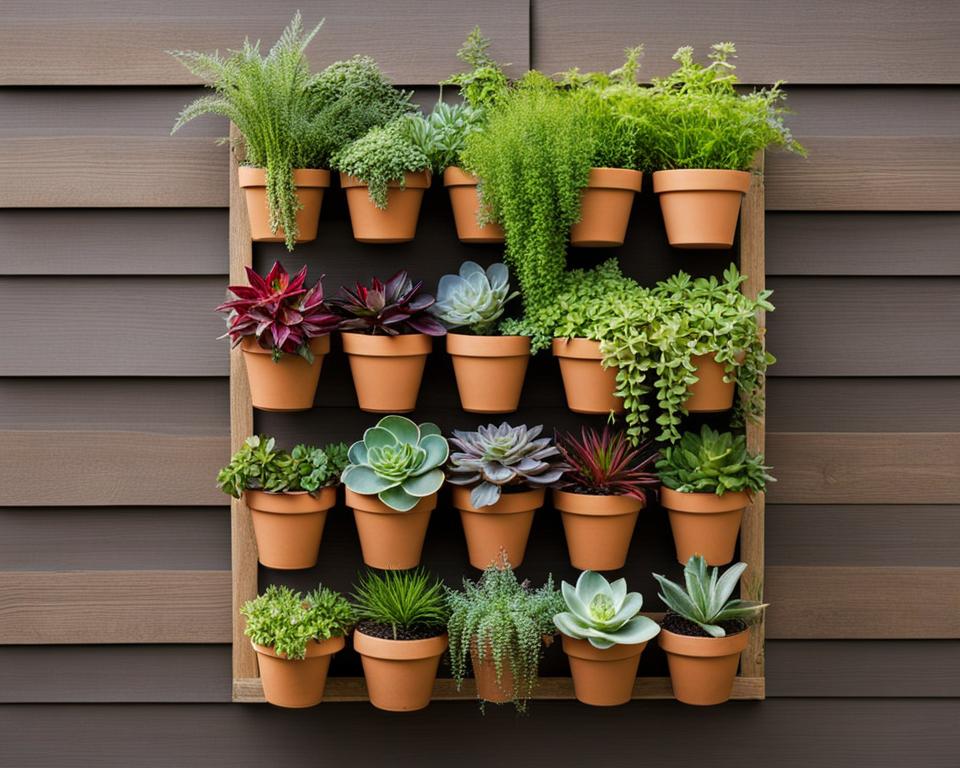
When pondering vertical garden design, the selection of plants is paramount to your garden’s success. For avid gardeners like yourself, understanding the best plants for vertical gardening can make all the difference. Certain species thrive in the unique environmental conditions presented by the vertical space, and incorporating these plants can be a significant step in elevating your garden both literally and figuratively.
Here are several plant suggestions you should consider:
- Cucumbers: With their tendency to climb and sprawl, cucumbers are ideal for your vertical garden. Supported with frames, strings, or trellises, they adapt well to upward growth.
- Tomatoes: Especially the indeterminate varieties that grow continuously throughout the season and are perfect for trellis support.
- Peas: Both sweet and traditional pea varieties are suitable for vertical gardening, as they naturally climb and can be easily trained up a trellis.
- Vining Beans: Whether you opt for pole beans or runner beans, their vining nature makes them suitable for vertical supports.
For those looking to add more than just vegetables, consider these:
- Squashes: They require more space but can be vertically trained to add a unique and edible aspect to your design.
- Pumpkin Varieties: Smaller varieties can succeed in a vertical setting when given appropriate support.
- Gourds: With an interesting variety of shapes and sizes, gourds can grow well on strong vertical structures, adding an ornamental touch.
This list of best plants for vertical gardening will jumpstart the practical implementation of your vertical gardening tips. Do remember to consider each plant’s individual light and space needs, as well as your local hardiness zone to ensure the best outcomes.
Ultimately, selecting the right plants is a dynamic process that should take into account the various factors of your unique vertical garden scenario. Enjoy the process of planning and watching your vertical garden flourish as a living artwork.
Vertical Gardening Systems and Techniques
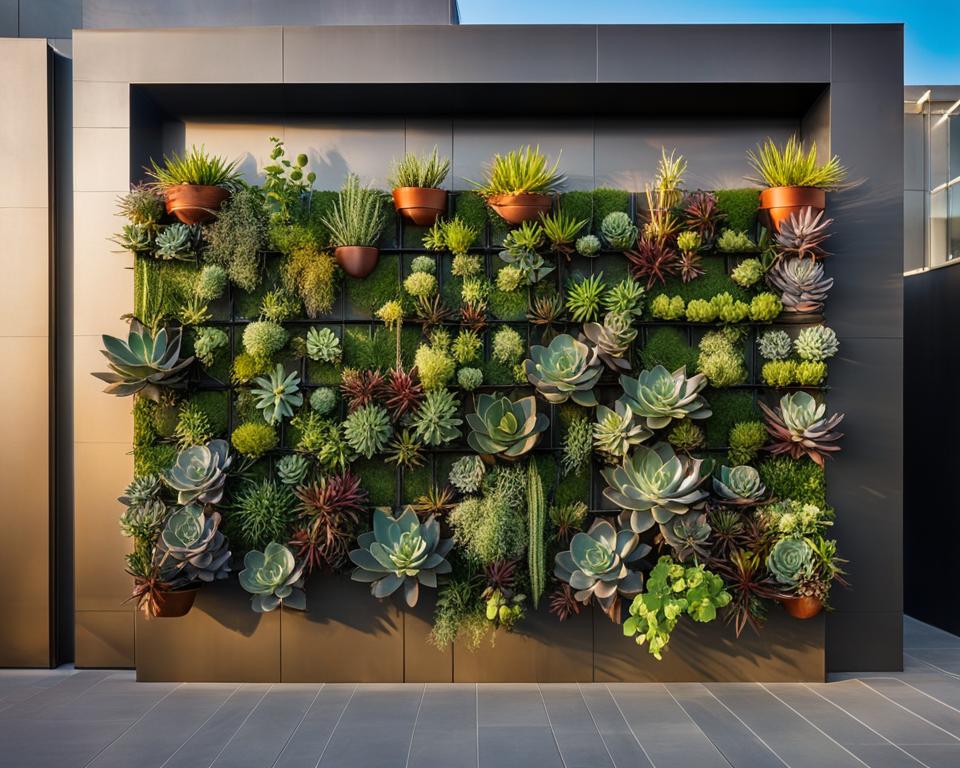
Embarking on the journey of vertical gardening unlocks a world of innovation and sustainability. As you pursue a thriving garden that reaches towards the skies, you are invited to explore a variety of vertical gardening systems and hone your vertical gardening techniques. Let’s delve into the diverse methods available, ensuring that your green endeavors contribute to a sustainable vertical ecosystem.
Understanding Different Vertical Gardening Methods
Whether you’re an urban gardener with a petite balcony or a suburban dweller with wall space to spare, there are vertical gardening ideas for every scenario. From the simple charm of wall planters to the intricate versatility of modular systems, each method serves to augment your living space with vibrant greenery. Be it the repurposing of gutters into flourishing herb displays or the construction of a serene green wall, these methods remain firmly rooted in sustainability and urban applicability.
Creating a Sustainable Vertical Ecosystem
Crafting a sustainable vertical ecosystem is a testament to your commitment to the environment. With plants ascending vertically, you are afforded the ability to not only grow a garden but also insulate your home, purify your air, and encourage biodiversity. This celebration of life, once confined to horizontal planes, now defies gravity, and its impact resonates far beyond aesthetic pleasure.
Below is a table contrasting various vertical gardening systems, highlighting their features to help you create a resilient and sustainable garden:
| System Type | Best For | Biodiversity Support | Maintenance Level |
|---|---|---|---|
| Wall Planters | Herbs and small flowering plants | Low to Moderate | Low |
| Repurposed Gutters | Compact vegetables and trailing plants | Moderate | Medium |
| Trellises and Towers | Vining plants and larger vegetables like squash | High | Medium to High |
| Green Walls | Diverse species, including ferns, perennials, and mosses | High | High |
| Modular Systems | Mixed plant varieties, offering flexibility | High | Variable |
As you navigate through these vertical gardening systems and learn more about vertical gardening techniques, remember that your efforts are more than just an expression of creativity. They are significant contributions to crafting sustainable ecosystems, right in the heart of your own living space.
Vertical Gardening Ideas for Indoor and Outdoor Spaces
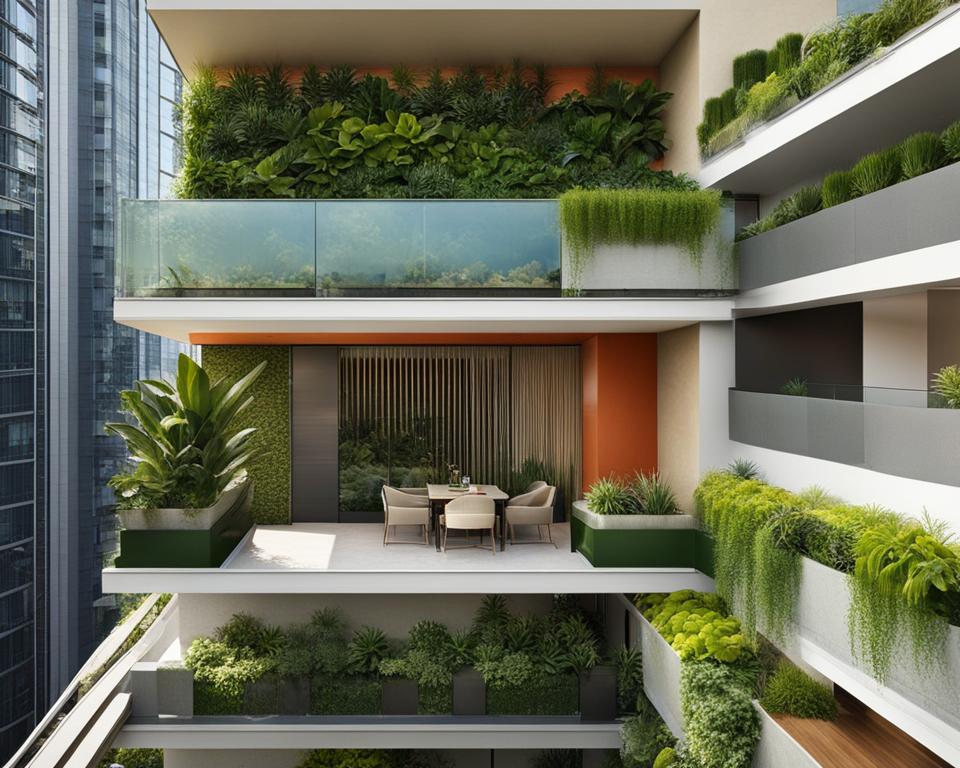
As cities grow more crowded, vertical gardening benefits urban dwellers by creating lush, vibrant areas in otherwise unused spaces. Whether you’re looking to spice up your indoor living areas or make the most of your urban balconies, vertical gardening offers a myriad of vertical gardening ideas to suit your needs and aesthetic preferences. From edible walls to decorative plant displays, vertical gardens enhance your environment and can even provide a fresh supply of herbs, vegetables, and flowers. Let’s explore some inspiring projects to maximize your living area with innovative vertical gardening concepts.
Inspiring Projects to Maximize Your Living Area
One of the most adaptable vertical gardening tips is to utilize wall planters, which can transform any wall into a green oasis. These planters can be arranged in multiple configurations to accommodate a variety of plant types and sizes. Consider a mixture of succulents, ferns, and trailing vines to create a textured, visually appealing garden that breathes life into your living space.
For those who are crafty, DIY hanging bottle gardens are an eco-friendly and budget-conscious approach. Simply reuse old plastic bottles, cut them open, and hang them with string or rope along a sunny wall or window. They’re perfect for small herbs or flowers and make a great conversation piece.
Vertical Gardening for Urban Balconies and Apartments
Urban balconies and small apartment patios are prime locations for implementing vertical gardening. These areas can be easily overlooked but hold the potential to be transformed into productive and enjoyable spaces.
If you’re limited on space but still dream of growing your own vegetables, consider a tiered herb and greens garden. Using stackable planters or terraced garden beds, you can grow a variety of edible plants without taking up much floor space.
| Project Type | Space Requirement | Suitable Plants | Notes |
|---|---|---|---|
| Wall Planters | Vertical wall space | Succulents, Ferns, Vines | Great for creating a live wall art display |
| Bottle Gardens | Minimal; use existing wall or window | Herbs, Small Flowers | Eco-friendly project; recycles plastic waste |
| Tiered Planters | Small footprint; ideal for balconies | Herbs, Lettuce, Strawberries | Maximizes vertical space; accessible for harvesting |
By integrating these vertical gardening ideas into your indoor or outdoor spaces, you not only add greenery to your home but also enjoy the multifaceted rewards that come with cultivating your own garden. Whether you live in a sprawling house with ample yard space or a cozy apartment with just a small balcony, vertical gardening opens up a new realm of possibilities for connecting with nature right at home.
Vertical Gardening Tips for Maintenance and Growth
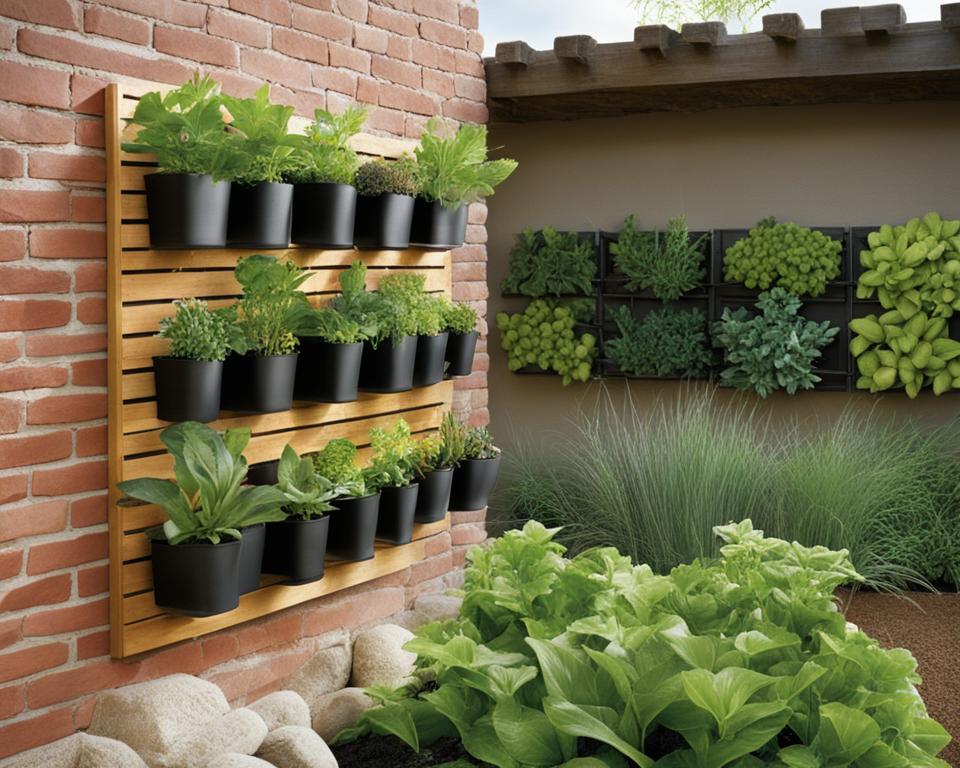
Embracing the practice of vertical gardening can revolutionize your space, but it also requires unique gardening tips to ensure your green wall thrives. Proper vertical garden maintenance is not only about preserving the beauty; it also involves promoting plant growth and health. To assist you in nurturing your vertical oasis, here are some fundamental tips and reminders.
- Ensure adequate watering: Implement a drip irrigation system or a self-watering planter to provide consistent moisture and avoid overwatering.
- Promote good drainage: To prevent root rot and other water-related diseases, confirm that your vertical garden containers have holes at the bottom for drainage, particularly when repurposing objects like gutters.
- Control plant weight: Select containers and structures that can support the weight of your plants, especially as they grow bigger and heavier.
- Regular pruning: Pruning isn’t just about size management; it encourages healthier and more robust plants. When growing tomatoes vertically, maintain a single lead vine to boost growth and yield.
- Protector measures: Tender plants like peas may attract birds. Use nets or other humane deterrents to protect your veggies without harming wildlife.
While gardening tips are invaluable, seeing practical examples of well-maintained vertical gardens can be truly inspiring. Below is a closer look at how certain gardening techniques can support the vibrant life of your vertical garden.
| Gardening Tip | Benefit | Example |
|---|---|---|
| Drip Irrigation Installation | Consistent hydration without water wastage | A series of micro-tubes running along each plant level |
| Utilizing Lightweight Grow Mediums | Reduces structural stress | Coco coir or peat moss mixtures |
| Pruning for Air Circulation | Reduces disease risk and improves plant health | Removal of lower leaves on tomato plants |
Remember that as your vertical garden develops and matures, maintenance will adapt to the changing needs of your plants. Observing your garden closely, adjusting care methods, and being proactive about potential issues will prolong the life and vibrancy of your vertical arrangement.
Finally, whether you are a seasoned gardener or a beginner, cultivating a successful vertical garden is a rewarding venture. Follow these maintenance and growth tips to enhance the quality and productivity of your vertical gardening efforts, ensuring lush greenery and bountiful harvests season after season.
Benefits of Vertical Gardening in Urban Settings

As urban landscapes continue to grow more densely populated, the benefits of vertical gardening are becoming ever more apparent. Not only does vertical greenery inject a much-needed splash of nature into the concrete jungle, but it also offers a viable avenue for urban agriculture. In dense city environments where horizontal space is at a premium, adding vertical gardens to buildings, balconies, and shared spaces can transform them drastically.
Improving Air Quality with Vertical Greenery
In the midst of busy city life, improving air quality is a predominant concern. Vertical gardens play a critical role in this regard by augmenting the urban landscape with living walls that filter pollutants and release oxygen. These green installations act as natural air purifiers, bringing fresh vitality to urban dwellers and facilitating a healthier living environment. By incorporating these gardens into façades, terraces, and rooftops, you can help negate the impact of pollutants and create an oasis of clean air.
Promoting Urban Agriculture Through Innovative Planting
As more individuals become invested in the source and sustainability of their food, vertical gardens offer a fresh perspective on urban agriculture. They allow city residents to cultivate their own produce such as vegetables, fruits, and herbs, despite the lack of traditional garden space. This push towards innovative planting isn’t only good for your dinner plate; it reduces your ecological footprint and bolsters local ecosystems. By supporting biodiversity and providing local, fresh food options, vertical gardens make urban agriculture both accessible and impactful.
| Aspect of Urban Gardening | Benefits |
|---|---|
| Space Efficiency | Allows for gardening in confined urban spaces |
| Air Quality Improvement | Filtration of pollutants and oxygen production |
| Sustainable Food Production | Enables growing fresh produce in city settings |
| Aesthetic Enhancement | Beautifies city environments with natural elements |
| Ecosystem Support | Promotes biodiversity with a variety of plants |
Reviving Your Space with Vertical Gardening
Discover the transformative power of vertical gardening tips that not only expand your planting options but revitalize any area with vibrant beauty. With the right creative vertical solutions, even the most compact spaces can bloom into a lush oasis. The beauty of vertical gardening lies in its versatility and the infinite possibilities it presents to personalize your living environment.
Maximizing Small Spaces with Creative Solutions
Imagine turning a bare balcony or a dull wall into a canvas of greenery. With creative vertical solutions, that underused corner of your apartment can become a focal point, brimming with life. Use pallets vertically to support a variety of herbs and succulents or employ a-frames to showcase trailing blooms that cascade like a natural tapestry. String trellises are perfect for vining vegetables, enabling you to grow upward and yield a harvest in minimal ground space. These innovations allow you to maximize small spaces in ways traditional gardening methods cannot.
Adding Life to Walls with Lush Plant Arrangements
Introduce lush plant arrangements to your walls and witness the metamorphosis from mundane to magnificent. Strategically select plants that not only adapt to vertical living but add depth and contrast to your arrangements. Employ climbers that weave through trellises or attach vibrant flowerpots to walls in patterns that captivate the eye. Each plant’s unique texture and color can turn a simple wall into a living work of art, providing you with a daily dose of nature’s splendor right in your urban locale.
Vertical gardening is not just an aesthetic choice—it’s a smart and efficient way to cultivate a personal connection with nature, irrespective of where you live. Whether you wish to grow herbs for your kitchen table or create a sanctum of peace, vertical gardening tips and creative solutions are your allies. They not only push the boundaries of traditional horticulture but also promise a lush, vertical paradise that maximizes the potential of every inch of your small space.
Conclusion
As we delve into the promising world of vertical gardening, it’s clear that this innovative approach is more than just a trend—it’s a transformative way to enhance home greenery and adopt a greener lifestyle. Whether your aim is to beautify a compact urban terrace or simply to elevate your home’s aesthetic with lush foliage, vertical gardening is your ally. With space at a premium, especially in city settings, this method maximizes every inch, turning bare walls and fences into vibrant, living tapestries.
Through the resourceful use of structures and a bit of creativity, you can leverage vertical gardening benefits that stretch beyond mere visual appeal. Producing your own herbs, vegetables, and flowers not only contributes to sustainable living but also instills a sense of accomplishment as you harvest the fruits of your labor. With a cornucopia of vertical gardening tips at your disposal, setting up your garden becomes an accessible activity, promising an enjoyable and fulfilling gardening experience, regardless of your level of expertise or the size of your living space.
Ultimately, embracing vertical gardening is an empowering step toward a more sustainable and aesthetically pleasing living environment. It’s a testament to the creative spirit of gardeners and home enthusiasts alike, showcasing how a touch of greenery can vastly improve the quality of life. So, harness the potential of vertical spaces, choose the right plants and designs, and watch as your vertical garden flourishes, bringing a new dimension of beauty and functionality to your home.
FAQ
What is vertical gardening?
Vertical gardening is a method of growing plants upward to maximize space, particularly in areas with limited horizontal space. It is ideal for urban environments, small gardens, patios, and interior decor, and can involve a variety of structures such as wall planters, trellises, and hanging systems.
How do you start a vertical garden?
To start a vertical garden, select a suitable location with enough light, choose the right vertical structure based on your space and design preferences, and pick plants that grow well in vertical conditions. Then set up your system, plant your selections, and implement proper maintenance routines.
What are the best plants for vertical gardening?
The best plants for vertical gardening are typically those that can climb, such as vine crops (like cucumbers and tomatoes), or can be easily supported, like peas, vining beans, smaller squash varieties, and certain flowers like morning glories and climbing hydrangea.
What are some vertical gardening design tips?
When designing a vertical garden, consider the visual impact as well as the functionality. Use structures that complement your space and provide proper support for the plants chosen. Focus on creating a balance between greenery and architectural elements to enhance the overall aesthetics.
How can vertical gardening enhance home greenery?
Vertical gardening can increase greenery in your home by utilizing unused vertical spaces to grow plants. It can transform bare walls, balconies, and fences into lush living spaces, contributing to both the aesthetic value and the environmental quality of your home.
What vertical gardening systems can I implement?
There are several systems you can use, including modular wall planters, repurposed gutters, PVC towers, and trellises with climbing plants. You can choose simple setups such as pallet gardens or more advanced green walls depending on your space and resources.
How do you maintain a vertical garden?
Maintain a vertical garden by ensuring adequate watering—consider drip irrigation—proper drainage, and regular pruning to manage growth. For heavy plants, make sure your structure can support the weight and that plants receive enough light and nutrients for optimal growth.
What are the benefits of vertical gardening in urban settings?
Vertical gardening in urban settings can help improve air quality by filtering pollutants, create additional growing areas for urban agriculture, enhance the beauty of the urban landscape, and contribute to better thermal insulation of buildings.
Can vertical gardening be used for growing food?
Absolutely. Vertical gardening can be very effective for growing a variety of foods, including herbs, leafy greens, and even some vegetables and fruits. It allows urban dwellers and those with limited space to cultivate their own produce.
What are some sustainable vertical gardening techniques?
Sustainable vertical gardening techniques include using recycled materials for planters, implementing water-efficient irrigation systems, choosing native or drought-resistant plants, and integrating pollinator-friendly species to promote biodiversity.

